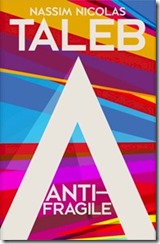- “Wind extinguishes a candle and energizes fire. Likewise with randomness, uncertainty, chaos; you want to use them, not hide from them. You want to be the fire and wish for the wind” – first line of Anti-Fragile
“Antifragile” is the inspired word of Embracing Failure.
Many wise individuals embrace failure, but its prophet has to be Nassim Taleb. All of his works are imbued with its spirit, but his latest book ‘Antifragile’ makes the principle its very heart and core.
It’s not a perfect book. It employs lots of anecdote which is fine as illustration, but can lead to causation fallacy. I also feel that Taleb is a bit unfairly harsh on academia. His “History Written by the Losers” chapter is particularly slighting of models versus “tinkering”, but I don’t think you build a nuclear reactor by tinkering.
Where does one begin to share such a rich trove of insights? I’ve decided to do a bit of a Readers Digest selection of favourite excerpts for those of you who can’t get through the Bible-sized 426 pages (and that’s without the extensive appendices). But even then, there is so much to share that I am going to parcel it out in a few posts over the coming week.
I’ve chunked the citations into some of the more prevalent categories I use on the blog as well as added a few bits of commentary. The first post today focuses on defining the terms. Taleb not only provides helpful definitions and categorisations, but he also deftly coins new terms where nothing conventional fits (or an existing term is too laden is misconstruing semantic baggage).
Of course, the first one of all is the very concept of “Antifragility” itself…
- Antifragile – “Some things benefit from shocks; they thrive and grow when exposed to volatility, randomness, disorder, and stressors and love adventure, risk, and uncertainty. Yet, in spite of the ubiquity of the phenomenon, there is no word for the exact opposite of fragile. Let us call it anti-fragile. Antifragile is beyond resilience or robustness. The resilient resists shocks and stays the same; the antifragile gets better…This property is behind everything that has changed with time: evolution, culture, ideas. Revolutions, political systems, technological innovation, cultural and economic progress, corporate survival, good recipes…, the rise of cities, cultures, legal systems, equatorial forests, bacterial resistance…even our own existence as a species on this planet..The antifragile loves randomness and uncertainty, which also means – crucially – a love of error, a certain class of errors. Antifragility has a singular property of allowing us to deal with the unknown, to do things without understanding them…We can almost always detect antifragility (and fragility) using a simple test of asymmetry: anything that has more upside than downside from random events (or certain shocks) is anti-fragile. The reverse is fragile.”
A sampling of others that he has either defined, re-defined or lifted from obscurity include…
- Mithridatization – “Let us call Mithridatization the result of an exposure to a small dose of a substance that, over time, makes one immune to additional, larger quantities of it. It is the sort of approach used in vaccination and allergy medicine. It is not quite antifragility…but we are on our way.”
- Hormesis – “A word coined by pharmacologists, is when a small dose of a harmful substance is actually beneficial for the organism, acting as a medicine.”
- Percolation Theory – “It is the system and its fragility, not events, that must be studied – what physicists call ‘percolation theory.’ In which the properties of the randomness of the terrain are studied rather than those of a single element of the terrain.”
- Losers – My characterisation of a loser is someone who, after making a mistake, doesn’t introspect it, doesn’t exploit it, feels embarrassed and defensive rather than enriched with a new piece of information and tries to explain why he made the mistake rather than moving on. These types often consider themselves the ‘victims’ of some large plot, a bad boss or bad weather.”
- Stoicism – “The key phrase reverberating in Seneca’s oeuvre is ‘nihil perditi’, “I lost nothing,” after an adverse event. Stoicism makes you desire the challenge of a calamity…Stoicism is about the domestication, not necessarily the elimination, of emotions…My idea of the modern Stoic sage is someone who transforms fear into prudence, pain into information, mistakes into initiation, and desire into undertaking.”
- Strategy – “It turns out, strategic planning is just superstitious babble.”
- Negative description – “Via negative does not try to express what God is…It just lists what God is not and proceeds by the process of elimination.” [metaphysical Sudoku].
- Subtractive epistemology – “The greatest-and most robust-contribution to knowledge consists of removing what we think is wrong…So knowledge grows by subtraction not addition.”
- Innovation – “People think focus means saying yes to the thing you’ve got to focus on. But that’s not what it means at all. It means saying no to the hundred other good ideas that there are. You have to pick carefully. I’m actually as proud of the things we haven’t done. Innovation is saying no to 1,000 things. – Steve Jobs”
- Herosim – Heroism is the exact inverse of the agency problem [ie. “Other People’s Money” accountability]: someone elects to bear the disadvantage (risks his own life, or harm to himself, or, in milder forms, accepts to deprive himself of some benefits) for the sake of others…In traditional societies, a person is only as respectable and as worthy as the downside he (or, a lot more, than expected, she) is willing to face for the sake of others…The robustness of society depends on them; if we are here today, it is because someone, at some stage, took some risks for us.”
- Pseudocourage – “Comes from risk blindness, in which people underestimate the odds of failure.”
- “Option = asymmetry + rationality”

3 comments
Do you want to comment?
Comments RSS and TrackBack URI
Trackbacks